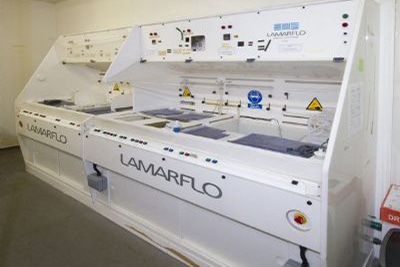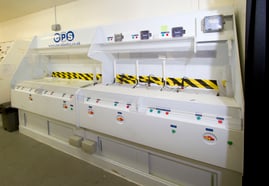What is Wet-Etching?

Wet etching is a material removal process that uses liquid chemicals or etchants to remove materials from a wafer, usually in specific patterns defined by masks on the wafer. Materials not covered by these masks are “etched away” by chemicals while those covered by masks are left intact. Wet etching processes have many possible applications, such as metals, glass, and plastics plating.
Wet Etching is the simplest process used for etching: wafers are either sprayed or immersed in a chemical bath using solutions such as hydrofluoric acid to etch a silicon dioxide over a silicon substrate. It is known as an isotropic etching because the corrosive action occurs in all direction simultaneously, at equal rates. Isotropic etching is usuallly used to remove material from a large surface and to clean circuits prior to electroplating.
Wet chemical cleaning is essential in solar cell fabrication to ensure silicon quality is maintained and to prevent contamination of equipment, which could contaminate samples. Surface contamination arising from “dirty wafers” can have disastrous effects on the bulk carrier lifetime of silicon wafer solar cells, especially if impurities are allowed to diffuse into the wafers through high temperature thermal processes such as diffusion. These impurities can contaminate production life components such as diffusion furnaces. Silicon wafers are cleaned through a series of wet chemical steps.
Organic Particle Removal
This first step is used to remove organic residuals from the water surface. Aqueous ammonium hydroxide is mixed with hydrogen peroxide and deionized water. Wafers are cleaned for 6-10 minutes at elevated temperatures 80°C before rinsing in deionized water. In this process, a thin oxide layer may form on the surface which would be removed later.
Ionic Clean
This treatment is used to remove metallic contaminants. The solution consists of a mixture of aqueous hydrochloric acid, H202 and deionized water. Like step 1, wafers are immersed in the solution for 6-10 minutes. The resulting wafers have a thin, chemically grown oxide that is either removed in an acid dip, or left on the surface to act as a passivation oxide.
Advantages of Wet Etching
- Equipment is very simple
- Easy to implement
- Can be easily industrialized
- The etch rate is particularly high, which makes etching fast and thus avoids destroying the protective layer.
- Good material selectivity.
At Riley Surface World, we have an Immersion treatment benches available at CPS Electroless Plating Bench for Numerous Wet Treatments
CPS Electroless Plating Bench for Numerous Wet Treatments
CPS Electroless Copper Plating Bench consists of a 6 station wet cleaning and electroless plating process, with 3 pre-treatment stations and 3 electroless plating stations respectively. This process is commonly used in semiconductor manufacturing or other high technology products.
- Stock No
- TZ270
- Category
- Associated Process Plant & Equipment
- Model
- CPS Wet Immersion Treatment Bench
- Work Envelope (WxDxH mm) [?]
- 300 x 300 x 200 x 8off
- Process Stages
- 8
- Other Info
- See images exceptional process support
- Condition
- Seen working by RSW, Excellent Condition
- Sold As Seen Price [?]
- £ 12,000 (+ VAT)
- Special Price (sold as seen) [?]
- Login or Register for price.
- Special offer ends
- 25 February 2026 15:00 GMT while stocks last
Machines & equipment for sale
- Surface Treatment
- Cleaning & Degreasing
- Polishing & Belt Linishing
- Mass Finishing
- Ovens & Furnaces
- Process Cooling
- Shot Blasting
- Dust & Fume Extraction
- Air Compressors
- Rectifiers & Transformers
- Miscellaneous
- Latest Stock
- Special Offers
- Direct From Site Clearances
- Auctions
- Brand New Machines
- Available Immediately
- Sell Your Machine
Machine Alert
Get the latest machines emailed directly to you as they become available to buy online. Sign Up Now



